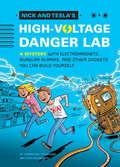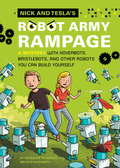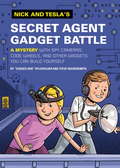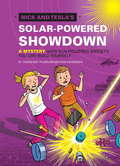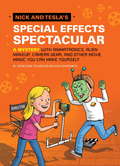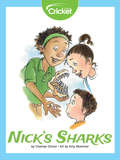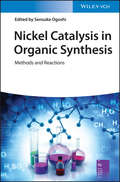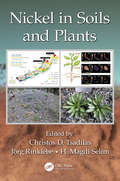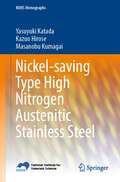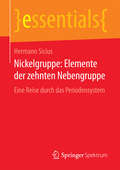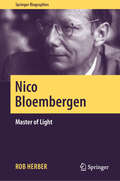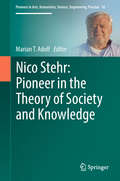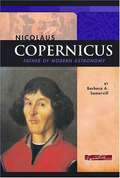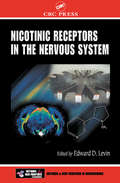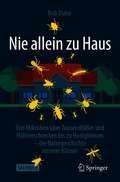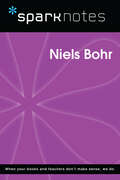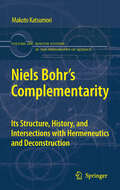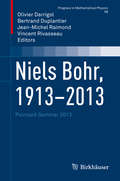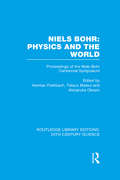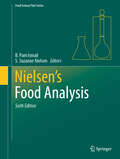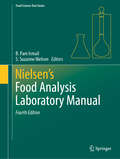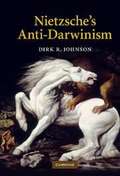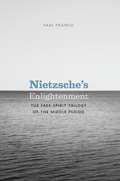- Table View
- List View
Nick and Tesla's High-Voltage Danger Lab: A Mystery with Electromagnets, Burglar Alarms, and Other Gadgets You Can Build Yourself (Nick and Tesla #1)
by Steve Hockensmith Bob PflugfelderNick and Tesla are bright 11-year-old siblings with a knack for science, electronics, and getting into trouble. When their parents mysteriously vanish, they're sent to live with their Uncle Newt, a brilliant inventor who engineers top-secret gadgets for a classified government agency. It's not long before Nick and Tesla are embarking on adventures of their own--engineering all kinds of outrageous MacGyverish contraptions to save their skin: 9-volt burglar alarms, electromagnets, mobile tracking devices, and more. Readers are invited to join in the fun as each story contains instructions and blueprints for five different projects.In Nick and Tesla's High-Voltage Danger Lab, we meet the characters and learn how to make everything from rocket launchers to soda-powered vehicles. Learning about science has never been so dangerous--or so much fun!
Nick and Tesla's Robot Army Rampage
by Steve Hockensmith Bob PflugfelderNick and Tesla return in an all-new, robot-filled adventure! When a rash of robberies hits the town of Half Moon Bay, 11-year-old sleuths Nick and Tesla are determined to catch the criminals--but to do so, they'll have to build a host of new gadgets and gizmos! In this robot-themed follow-up to Nick and Tesla's High-Voltage Danger Lab, the brother-and-sister duo build four different droids out of ordinary household objects--and illustrated instructions are included throughout the story, so you can build them, too! Make bristlebots that buzz, hoverbots that float above the ground, battlebots that duke it out, and more! Can Nick and Tesla catch the criminal mastermind--and foil his army of rampaging robots--before it's too late?
Nick and Tesla's Secret Agent Gadget Battle
by Steve Hockensmith Bob PflugfelderAfter foiling a gang of kidnappers and fending off an army of robots, 11-year-old siblings Nick and Tesla Holt could use a little rest! But as their third mystery opens, they discover there's a spy in their midst, searching for secrets in the home of their beloved (and slightly crazy) Uncle Newt. Is it the new laboratory assistant? The exterminator? The housekeepers? Or someone completely unexpected? To expose the mystery agent, Nick and Tesla must engineer all kinds of outrageous contraptions, from code wheels and fingerprint powder to spy cameras and burglar detectors. Best of all, instructions are included throughout the story, so you can build the projects, too!
Nick and Tesla's Solar-Powered Showdown: A Mystery with Sun-Powered Gadgets You Can Build Yourself
by Steve Hockensmith Bob PflugfelderKid inventors Nick and Tesla Holt have outsmarted crooks, spies, and kidnappers. Now they have to crack their biggest mystery yet: Where the heck are their parents? To outwit the criminal mastermind who's holding their parents hostage, the twins will need all their brainpower, the help of their eccentric Uncle Newt, and an assortment of homemade solar gadgets. Will the Holt family be reunited at last? Or will a hijacked solar satellite beam down doom from the skies? The adventure includes instructions for creating a solar-powered hot-dog cooker, alarm, secret listening device, and model car, plus a nighttime signal cannon that fires illuminated ping-pong balls.
Nick and Tesla's Special Effects Spectacular
by Steve Hockensmith Bob PflugfelderWhat do a pair of kid inventors with a knack for science and electronics do when Hollywood comes to town? Why save the day, of course! In Nick and Tesla's Special Effects Spectacular, 11-year-old siblings Nick and Tesla Holt find themselves on the set of a big-budget superhero movie. But someone's sabotaging the onscreen debut of their favorite comic book hero, so the brother and sister sleuths must crack the case with the help of a fresh assortment of homemade special-effects gadgets. This cinematic saga features instructions for all-new movie magic projects that kids can build themselves, such as camera gear, stunt dummies, make-up magic, and more. Science and electronics have never been so much fun! "How do you connect students interested in STEM (science, technology, engineering, mathematics) with fiction reading? Look for science adventures. Get started with the Nick and Tesla series. Each book contains an engaging adventure revolving around a 'build-it-yourself' science project."--Teacher Librarian"Real project blueprints are included along with this tale of 11-year-old siblings who create outrageous contraptions and top-secret gadgets."--Los Angeles Times
Nick and Tesla's Super-Cyborg Gadget Glove
by Steve Hockensmith Bob PflugfelderBright siblings--and amateur inventors--Nick and Tesla Holt are back in this fourth installment of their whiz-bang middle-grade series. This time, the twins are out to save science itself, as they race against the clock to figure out why a robotic assortment of history's greatest scientists and inventors keeps going haywire. Is this sabotage, robo-geddon...or something more sinister? To unravel the mystery, they'll have to keep adding all-new gadgets to their cyborg glove as they stay one step ahead of a hidden adversary. Together with zany scientist Uncle Newt and their friends Silas and DeMarco, Nick and Tesla won't give up until an answer is found...but can they do it before time runs out? In this book, readers will learn how to construct a super-cyborg gadget glove that has four incredible functions: LED signal light, ultra-loud emergency alarm, handy sound recorder, and UV secret message revealer. Science and electronics have never been so much fun!
Nick's Sharks
by Charnan SimonNick is afraid of sharks. He'd much rather spend his time safely on the beach than in the water with sharks! To help Nick get over his fear, his sister takes him to an aquarium. Will this special trip help him learn that sharks aren't scary?
Nickel Catalysis in Organic Synthesis: Methods and Reactions
by Sensuke OgoshiA comprehensive reference to nickel chemistry for every scientist working with organometallic catalysts Written by one of the world?s leading reseachers in the field, Nickel Catalysis in Organic Synthesis presents a comprehensive review of the high potential of modern nickel catalysis and its application in synthesis. Structured in a clear and assessible manner, the book offers a collection of various reaction types, such as cross-coupling reactions, reactions for the activation of unreactive bonds, carbon dioxide fixation, and many more. Nickel has been recognized as one of the most interesting transition metals for homogeneous catalysis. This book offers an overview to the recently developed new ligands, new reaction conditions, and new apparatus to control the reactivity of nickel catalysts, allowing scientists to apply nickel catalysts to a variety of bond-forming reactions. A must-read for anyone working with organometallic compounds and their application in organic synthesis, this important guide: -Reviews the numerous applications of nickel catalysis in synthesis -Explores the use of nickel as a relatively cheap and earth-abundant metal -Examines the versatility of nickel catalysis in reactions like cross-coupling reactions and CH activations -Offers a resource for academics and industry professionals Written for catalytic chemists, organic chemists, inorganic chemists, structural chemists, and chemists in industry, Nickel Catalysis in Organic Synthesis provides a much-needed overview of the most recent developments in modern nickel catalysis and its application in synthesis.
Nickel in Soils and Plants (Advances in Trace Elements in the Environment)
by Christos Tsadilas Jörg Rinklebe Magdi SelimSoils with high Ni contents occur in several parts of the world, especially in areas with ultramafic rocks which cause serious environmental impacts. This book aims to extend the knowledge on the risks and problems caused by elevated Ni contents and to cover the existing gaps on issues related to various aspects and consequences of high Ni contents in soils and plants. Nickel in Soils and Plants brings together discussions on Ni as a trace element and as a micronutrient essential for plant growth and its role in plant physiology. It analyzes the biogeochemistry of Ni at the soil plant interface, and explains its behavior in the rhizosphere resulting in Ni deficiency or toxicity, or Ni tolerance of various Ni hyperaccumulators. Included are Ni resources and sources, the origin of soil Ni, its geochemical forms in soils and their availability to plants, a special reference on soils enriched with geogenic Ni, such as serpentine soils, and the special characteristics of those ecosystems. Recent advancements in methods of Ni speciation, including the macroscale and X- ray absorption spectroscopy studies as well as serious views on Ni kinetics, are also covered. Written by a team of internationally recognized researchers and expert contributors, this comprehensive work addresses the practical aspects of managing Ni in soils and plants for agricultural production, and managing soils with high Ni levels by using organic and inorganic amendments. The text also addresses practical measures related to Ni toxicity in plants, the removal and recovery of Ni from high Ni wastes, and offers environmentally friendly innovative processes for mining Ni from soils containing high Ni levels.
Nickel-saving Type High Nitrogen Austenitic Stainless Steel (NIMS Monographs)
by Yasuyuki Katada Kazuo Hirose Masanobu KumagaiThis book describes the details of the research and development of nickel-saving high nitrogen austenitic stainless steel and high nitrogen steel (HNS) with excellent corrosion resistance in the sea. This resistance was realized by using nitrogen (N), one of the ubiquitous elements, as an alloying element. By using N it is possible to save nickel (Ni), a national strategic substance in Japan, to be partially reduced or to be totally free. Not only basic information about low nickel HNS but also its promising application to bipolar plates of solid polymer fuel cells are provided. Reduction of Ni ions in the cell environment can be expected to extend the life of the fuel cell. Furthermore, there is discussion of the serendipitous application and impact of nickel-free HNS in the field of biomaterials as an anti-nickel allergy material, leading to its development for coronary stents.The book includes an explanation of how to develop extremely high corrosion-resistance steel by controlling its level of oxygen. For researchers and engineers involved in the development and evaluation of corrosion-resistant materials in particular, this book is extremely helpful for understanding the details of the development of those materials.
Nickelgruppe: Eine Reise durch das Periodensystem (essentials)
by Hermann SiciusHermann Sicius stellt ausf#65533;hrlich die Elemente der zehnten Nebengruppe (Nickel, Palladium, Platin und Darmstadtium) vor, deren physikalische und chemische Eigenschaften relativ #65533;hnlich sind. Nickel wurde 1751 entdeckt, Palladium 1803, und Platin war zumindest in legierter Form schon in Alt#65533;gypten bekannt. Auch beim Elementenpaar Palladium und Platin erkennt man noch die Auswirkung der Lanthanoidenkontraktion. Die jeweiligen physikalischen Eigenschaften dieser zwei Elemente unterscheiden sich jedoch schon merklich, nicht aber die chemischen. Die Eigenschaften des Nickels dagegen weichen von denen der zwei ,,edlen" Platinmetalle Palladium und Platin deutlich ab. So zeigt Nickel ein negatives Normalpotential sowie niedrigere Dichten, Schmelz- und Siedepunkte. Bei Nickel ist die Oxidationsstufe +2 die stabilste, Palladium und Platin treten jeweils mit der Oxidationsstufe +2 und +4 auf und Iridium mit +4. 1994 konnten die ersten Atome des Darmstadtiums erzeugt werden.
Nico Bloembergen: Master of Light (Springer Biographies)
by Rob HerberThis biography is a personal portrait of one of the best-known Dutch physicists, Nicolaas Bloembergen. Born in 1920 in Dordrecht, Bloembergen studied physics in Utrecht, leaving after World War II for the United States, where he became an American citizen in 1958. At Harvard University, he pioneered nuclear magnetic resonance (NMR, used in chemistry and biology for structure identification; moreover leading to MRI), laser theory and nonlinear optics. In 1978 he was awarded the Lorentz Medal for his contribution to the theory of nonlinear optics (used in fiber optics), and in 1981 he received the Nobel Prize for physics, along with Arthur Schawlow and Kai Siegbahn. The book is based on numerous conversations with Nicolaas Bloembergen himself, his wife Deli Brink, his family, and colleagues in science. It describes his childhood and study in Bilthoven and Utrecht, the first postwar years at Harvard, the discoveries of masers and lasers, and the award of the Nobel Prize. It also delves into Bloembergen's involvement in American politics, particularly his role in Ronald Reagan's controversial "Star Wars" program.
Nico Stehr: Pioneer in the Theory of Society and Knowledge (Pioneers in Arts, Humanities, Science, Engineering, Practice #16)
by Marian T. AdolfThis unique volume brings together a selection of the most important texts of Nico Stehr for the first time and puts them in dialogue with original research that draws on his prolific work. Covering five decades of pioneering sociological research on the theory of society and knowledge, the book introduces the reader to Stehr’s seminal inquiries into the economic, political and social role of knowledge. Original concepts, such as his groundbreaking studies on the Knowledge Society, are introduced as the volume traces Stehr’s pursuit of social scientific research as a source of practical knowledge for modern society.The book comprises three parts devoted to the many facets and the remarkable range of Nico Stehr’s oeuvre. Part 1 provides an introduction to the significance of his pioneering work and career. Part 2 demonstrates the practical application of Nico Stehr’s research as seen through the eyes of eminent scholars. Part 3 presents a selection of the milestones of his publications.
Nicolaus Copernicus: Father of Modern Astronomy
by Barbara A. SomervillA biography profiling the life and controversial ideas of Nicolaus Copernicus, the founder of modern astronomy who through his observations of the stars and planets, discovered that the sun was the center of the universe, which challenged the teachings of the Roman Catholic Church. Includes source notes and timeline.
Nicotinic Receptors in the Nervous System (Frontiers in Neuroscience)
by Edward D. LevinFeaturing a unique approach, Nicotinic Receptors in the Nervous System provides integrated coverage of research on neuronal nicotinic systems relevant to smoking addiction and cognitive dysfunction. By bringing together molecular and neurochemical applications, the book provides the key to understanding function and dysfunction of nicotinic systems and how they are significant for disease, addiction, and the development of novel drug treatments. The book presents readers with the basic mechanistic background for these treatments as well as the functional assessment necessary to determine therapeutic effects.
Nie allein zu Haus: Von Mikroben über Tausendfüßer und Höhlenschrecken bis zu Honigbienen – die Naturgeschichte unserer Häuser
by Rob DunnDieses Buch lässt einen das eigene Zuhause mit anderen Augen sehen.Selbst wenn die Böden blitzsauber sind und das Haus leer erscheint, sind unsere Häuser voller Leben. In Nie allein zu Haus stellt uns der Biologe Rob Dunn die fast 200.000 Arten vor, die bei uns zu Hause leben, von den ägyptischen Mehlmotten in unseren Schränken über die Kamelgrillen in unseren Kellern bis hin zum Laktobazillus, der auf unseren Küchenarbeitsplatten lebt. Während wir davon besessen sind, unsere Häuser zu sterilisieren und unsere Räume von der Natur zu trennen, bauen wir unbewusst einen völlig neuen Spielplatz für die Evolution. Der neue Lebensraum beeinflusst die Organismen, die mit uns leben, bringt einige dazu gefährlicher zu werden, und untergräbt gleichzeitig jene Arten, die unserem Körper gut tun oder uns helfen, bedrohlichere Organismen in Schach zu halten.
Niels Bohr (SparkNotes Biography Guide)
by SparkNotesNiels Bohr (SparkNotes Biography Guide) Making the reading experience fun! SparkNotes Biography Guides examine the lives of historical luminaries, from Alexander the Great to Virginia Woolf. Each biography guide includes:An examination of the historical context in which the person lived A summary of the person&’s life and achievements A glossary of important terms, people, and events An in-depth look at the key epochs in the person&’s career Study questions and essay topics A review test Suggestions for further reading Whether you&’re a student of history or just a student cramming for a history exam, SparkNotes Biography guides are a reliable, thorough, and readable resource.
Niels Bohr and Complementarity
by Arkady PlotnitskyThis book offers a discussion of Niels Bohr's conception of "complementarity," arguably his greatest contribution to physics and philosophy. By tracing Bohr's work from his 1913 atomic theory to the introduction and then refinement of the idea of complementarity, and by explicating different meanings of "complementarity" in Bohr and the relationships between it and Bohr's other concepts, the book aims to offer a contained and accessible, and yet sufficiently comprehensive account of Bohr's work on complementarity and its significance.
Niels Bohr's Complementarity
by Makoto KatsumoriThis book explores the modern physicist Niels Bohr's philosophical thought, specifically his pivotal idea of complementarity, with a focus on the relation between the roles of what he metaphorically calls "spectators" and "actors." It seeks to spell out the structural and historical complexity of the idea of complementarity in terms of different modes of the 'spectator-actor' relation, showing, in particular, that the reorganization of Bohr's thought starting from his 1935 debate with Einstein and his collaborators is characterized by an extension of the dynamic conception of complementarity from non-physical contexts to the very field of quantum theory. Further, linked with this analysis, the book situates Bohr's complementarity in contemporary philosophical context by examining its intersections with post-Heideggerian hermeneutics as well as Derridean deconstruction. Specifically, it points to both the close affinities and the differences between Bohr's idea of the 'actor-spectator' relation and the hermeneutic notion of the relation between "belonging" and "distanciation."
Niels Bohr, 1913-2013
by Vincent Rivasseau Olivier Darrigol Bertrand Duplantier Jean-Michel RaimondThis fourteenth volume in the Poincaré Seminar Series is devoted to Niels Bohr, his foundational contributions to understanding atomic structure and quantum theory and their continuing importance today. This book contains the following chapters: - Tomas Bohr, Keeping Things Open; - Olivier Darrigol, Bohr's Trilogy of 1913; -John Heilbron, The Mind that Created the Bohr Atom; - Serge Haroche & Jean-Michel Raimond, Bohr's Legacy in Cavity QED; - Alain Aspect, From Einstein, Bohr, Schrödinger to Bell and Feynman: a New Quantum Revolution?; - Antoine Browaeys, Interacting Cold Rydberg Atoms: A Toy Many-Body System; - Michel Bitbol & Stefano Osnaghi, Bohr´s Complementarity and Kant´s Epistemology. Dating from their origin in lectures to a broad scientific audience these seven chapters are of high educational value. This volume is of general interest to physicists, mathematicians and historians.
Niels Bohr: Physics and the World (Routledge Library Editions: 20th Century Science)
by Herman Feshbach Tetsuo Matsui Alexandra OlesonContaining the proceedings of the symposium held by the American Academy of Arts and Sciences to celebrate the 100th anniversary of the birth of Niels Bohr, this collection was first published in 1988. More than any other individual, Bohr was responsible for the development of quantum mechanics and for many of its applications in the pursuit of fundamental understanding of physical reality. In addition to his unique role in the discovery and elucidation of quantum theory, Bohr led the study of the fission of nuclei and was greatly concerned with the impact of the existence of the atomic bomb in the post-World War II era. This unique volume provides a panoramic view of modern physics, some of the philosophical issues associated with quantum theory, the impact of this momentous scientific development on the political circumstance of the Cold War Era and the qualities of a superlative scientist.
Nielsen's Food Analysis (Food Science Text Series)
by S. Suzanne Nielsen B. Pam IsmailThis sixth edition provides information on techniques needed to analyze foods for chemical and physical properties. The book is ideal for undergraduate courses in food analysis and it is also an invaluable reference for professionals in the food industry. General information chapters on regulations, labeling sampling, and data handling provide background information for chapters on specific methods to determine chemical composition and characteristics, physical properties, and constituents of concern. Methods of analysis cover information on the basic principles, advantages, limitations, and applications. The information on food analysis applications has been expanded in a number of chapters that cover basic analytical techniques. Instructors who adopt the textbook can contact B. Ismail for access to a website with related teaching materials.
Nielsen's Food Analysis Laboratory Manual (Food Science Text Series)
by S. Suzanne Nielsen B. Pam IsmailThis fourth edition laboratory manual was written to accompany Nielsen’s Food Analysis, Sixth Edition, by the same authors. New to this fourth edition of the laboratory manual are three new chapters that complement both the textbook chapters and the laboratory exercises. The book again contains four introductory chapters that help prepare students for doing food analysis laboratory exercises. The 26 laboratory exercises in the manual cover 24 of the 35 chapters in the textbook. Many of the laboratory exercises have multiple sections to cover several methods of analysis for a particular food component or characteristic. Most of the laboratory exercises include the following: background, reading assignment, objective, principle of method, chemicals, reagents, precautions and waste disposal, supplies, equipment, procedure, data and calculations, questions, and references. This laboratory manual is ideal for the laboratory portion of undergraduate courses in food analysis.
Nietzsche'S anti-Darwinism
by Dirk R. JohnsonFriedrich Nietzsche's complex connection to Charles Darwin has been much explored, and both scholarly and popular opinions have tended to assume a convergence in their thinking. In this study, Dirk Johnson challenges that assumption and takes seriously Nietzsche's own explicitly stated "anti-Darwinism. " He argues for the importance of Darwin for the development of Nietzsche's philosophy, but he places emphasis on the antagonistic character of their relationship and suggests that Nietzsche's mature critique against Darwin represents the key to understanding his broader (anti-)Darwinian position. He also offers an original reinterpretation of the Genealogy of Morals, a text long considered sympathetic to Darwinian naturalism, but which he argues should be taken as Nietzsche's most sophisticated critique of both Darwin and his followers. His book will appeal to all who are interested in the philosophy of Nietzsche and its cultural context.
Nietzsche's Enlightenment: The Free-Spirit Trilogy of the Middle Period
by Paul FrancoWhile much attention has been lavished on Friedrich Nietzsche’s earlier and later works, those of his so-called middle period have been generally neglected, perhaps because of their aphoristic style or perhaps because they are perceived to be inconsistent with the rest of his thought. With Nietzsche’s Enlightenment, Paul Franco gives this crucial section of Nietzsche’s oeuvre its due, offering a thoughtful analysis of the three works that make up the philosopher’s middle period: Human, All too Human; Daybreak; and The Gay Science. It is Nietzsche himself who suggests that these works are connected, saying that their “common goal is to erect a new image and ideal of the free spirit.” Franco argues that in their more favorable attitude toward reason, science, and the Enlightenment, these works mark a sharp departure from Nietzsche’s earlier, more romantic writings and differ in important ways from his later, more prophetic writings, beginning with Thus Spoke Zarathustra. The Nietzsche these works reveal is radically different from the popular image of him and even from the Nietzsche depicted in much of the secondary literature; they reveal a rational Nietzsche, one who preaches moderation instead of passionate excess and Dionysian frenzy. Franco concludes with a wide-ranging examination of Nietzsche’s later works, tracking not only how his outlook changes from the middle period to the later but also how his commitment to reason and intellectual honesty in his middle works continues to inform his final writings.
